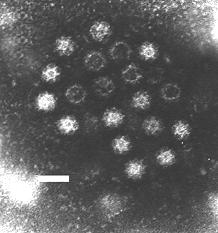
Coronaviruses are a group of related RNA viruses that cause diseases in mammals and birds. In humans and birds, they cause respiratory tract infections that can range from mild to lethal. Mild illnesses in humans include some cases of the common cold, while more lethal varieties can cause SARS, MERS, and COVID-19. In cows and pigs they cause diarrhea, while in mice they cause hepatitis and encephalomyelitis.

The family Filoviridae, a member of the order Mononegavirales, is the taxonomic home of several related viruses that form filamentous infectious viral particles (virions) and encode their genome in the form of single-stranded negative-sense RNA. Two members of the family that are commonly known are Ebola virus and Marburg virus. Both viruses, and some of their lesser known relatives, cause severe disease in humans and nonhuman primates in the form of viral hemorrhagic fevers. All filoviruses are Select Agents, World Health Organization Risk Group 4 Pathogens, National Institutes of Health/National Institute of Allergy and Infectious Diseases Category A Priority Pathogens, Centers for Disease Control and Prevention Category A Bioterrorism Agents, and listed as Biological Agents for Export Control by the Australia Group.

The laboratory mouse or lab mouse is a small mammal of the order Rodentia which is bred and used for scientific research. Laboratory mice are usually of the species Mus musculus. They are the most commonly used mammalian research model and are used for research in genetics, psychology, medicine and other scientific disciplines. Mice belong to the Euarchontoglires clade, which includes humans. This close relationship, the associated high homology with humans, their ease of maintenance and handling, and their high reproduction rate, make mice particularly suitable models for human-oriented research. The laboratory mouse genome has been sequenced and many mouse genes have human homologues.

The genus Ebolavirus is a virological taxon included in the family Filoviridae, order Mononegavirales. The members of this genus are called ebolaviruses, and encode their genome in the form of single-stranded negative-sense RNA. The six known virus species are named for the region where each was originally identified: Bundibugyo ebolavirus, Reston ebolavirus, Sudan ebolavirus, Taï Forest ebolavirus, Zaire ebolavirus, and Bombali ebolavirus. The last is the most recent species to be named and was isolated from Angolan free-tailed bats in Sierra Leone.

Coronaviridae is a family of enveloped, positive-strand RNA viruses which infect amphibians, birds, and mammals. The group includes the subfamilies Letovirinae and Orthocoronavirinae; the members of the latter are known as coronaviruses.

The Caliciviridae are a family of "small round structured" viruses, members of Class IV of the Baltimore scheme. Caliciviridae bear resemblance to enlarged picornavirus and was formerly a separate genus within the picornaviridae.They are positive-sense, single-stranded RNA which is not segmented. Thirteen species are placed in this family, divided among eleven genera. Diseases associated with this family include feline calicivirus, rabbit hemorrhagic disease virus, and Norwalk group of viruses (gastroenteritis). Caliciviruses naturally infect vertebrates, and have been found in a number of organisms such as humans, cattle, pigs, cats, chickens, reptiles, dolphins and amphibians. The caliciviruses have a simple construction and are not enveloped. The capsid appears hexagonal/spherical and has icosahedral symmetry with a diameter of 35–39 nm.

Cannabis indica is an annual plant in the family Cannabaceae. It is a putative species of the genus Cannabis. Whether it and Cannabis sativa are truly separate species is a matter of debate. The Cannabis indica plant is cultivated for many purposes; for example, the plant fibers can be converted into cloth. Cannabis indica produces large amounts of tetrahydrocannabinol (THC). The higher concentrations of THC provide euphoric effects making it popular for use both as a recreational and medicinal drug.
Rubrobacter is a genus of Actinobacteria, given its own subclass (Rubrobacteridae). It is radiotolerant and may rival Deinococcus radiodurans in this regard.

Cannabis strains are either pure or hybrid varieties of the plant genus Cannabis, which encompasses the species C. sativa, C. indica, and C. ruderalis.
Duganella is a genus of bacteria in the Oxalobacteraceae family.
Armatimonadetes is a phylum of gram-negative bacteria.
Duganella zoogloeoides is a bacterium of the genus Duganella in the Oxalobacteraceae family. In a phylogenetic analysis of Zoogloea ramigera, it has been shown to belong to the beta subclass of the class Proteobacteria which means Z. ramigera should be reclassified as a new taxon name, Duganella zoogloeoides.
Cupriavidus basilensis is a gram-negative soil bacterium of the genus Cupriavidus and the family Burkholderiaceae. The complete genome sequence of its type strain has been determined and is publicly available at DNA Data Bank of Japan, European Nucleotide Archive and GenBank, under the accession numbers CP062803, CP062804, CP062805, CP062806, CP062807, CP062808, CP062809 and CP062810.
Zoogloea ramigera is a gram-negative, aerobic bacterium from the genus of Zoogloea which occurs in organically enriched aqueous environments like activated sludges.
Zoogloea oryzae is a nitrogen-fixing, catalase and oxidase-positiv, motile bacterium with a polar flagellum from the genus of Zoogloea which was isolated from the soil from a rice paddy field.
Shinella zoogloeoides is a bacterium of the family Rhizobiaceae.

BacDive is a bacterial metadatabase that provides strain-linked information about bacterial and archaeal biodiversity.

Mymonaviridae is a family of negative-strand RNA viruses in the order Mononegavirales. Fungi serve as natural hosts. The name is a portmanteau of Ancient Greek myco, which means fungus, and mononegavirales. This family was established to accommodate Sclerotinia sclerotiorum negative-stranded RNA virus 1 (SsNSRV-1) a novel virus discovered in a hypovirulent strain of Sclerotinia sclerotiorum.

Genomoviridae is a family of single stranded DNA viruses. The genomes of this family are small. The genomes are circular single-stranded DNA and encode rolling-circle replication initiation proteins (Rep) and unique capsid proteins. In Rep-based phylogenies, genomoviruses form a sister clade to plant viruses of the family Geminiviridae. Ten genera are recognized in this family.
Zoogloea oleivorans is a gram-negative bacterium from the genus of Zoogloea. Its type strain was isolated from a filter for petroleum hydrocarbons from a site in Hungary.










